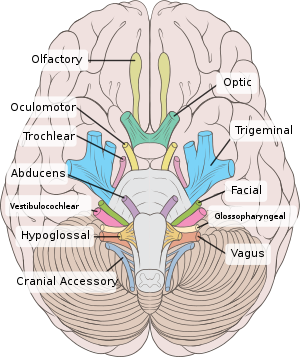Trigeminal
| Trigeminal nerve | |
|---|---|

Schematic illustration of the trigeminal nerve and the organs (or structures) it supplies
|
|

Inferior view of the human brain, with cranial nerves labelled
|
|
| Details | |
| To |
Ophthalmic nerve Maxillary nerve Mandibular nerve |
| Identifiers | |
| Latin | Nervus trigeminus |
| MeSH | A08.800.800.120.760 |
| Dorlands /Elsevier |
n_05/12566963 |
| TA | A14.2.01.012 |
| FMA | 50866 |
|
Anatomical terms of neuroanatomy
[]
|
|
The trigeminal nerve (the fifth cranial nerve, or simply CN V) is a nerve responsible for sensation in the face and motor functions such as biting and chewing. The largest of the cranial nerves, its name ("trigeminal" = tri-, or three and -geminus, or twin; thrice-twinned) derives from the fact that each trigeminal nerve (one on each side of the pons) has three major branches: the ophthalmic nerve (V1), the maxillary nerve (V2), and the mandibular nerve (V3). The ophthalmic and maxillary nerves are purely sensory, and the mandibular nerve has sensory (or "cutaneous") and motor functions.
Sensory information from the face and body is processed by parallel pathways in the central nervous system. The motor division of the trigeminal nerve derives from the basal plate of the embryonic pons, and the sensory division originates in the cranial neural crest.
The three major branches of the trigeminal nerve—the ophthalmic nerve (V1), the maxillary nerve (V2) and the mandibular nerve (V3)—converge on the trigeminal ganglion (also called the semilunar ganglion or gasserian ganglion), located within Meckel's cave and containing the cell bodies of incoming sensory-nerve fibers. The trigeminal ganglion is analogous to the dorsal root ganglia of the spinal cord, which contain the cell bodies of incoming sensory fibers from the rest of the body.
From the trigeminal ganglion a single, large sensory root enters the brainstem at the level of the pons. Immediately adjacent to the sensory root, a smaller motor root emerges from the pons at the same level. Motor fibers pass through the trigeminal ganglion on their way to peripheral muscles, but their cell bodies are located in the nucleus of the fifth nerve, deep within the pons.
...
Wikipedia
